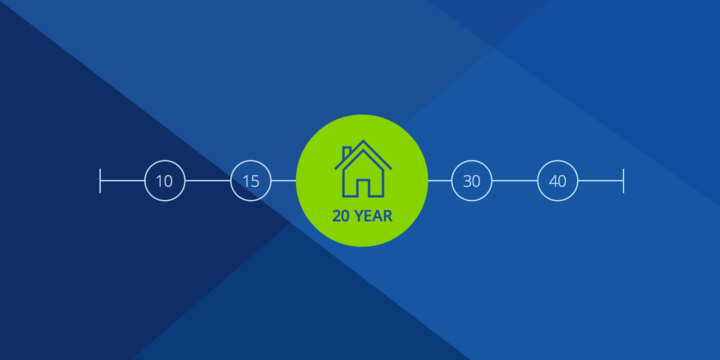5 min read
Fannie Mae vs Freddie Mac: What's the Difference?


Written by Alycia Lucio on June 17, 2024
Fannie Mae and Freddie Mac are government-sponsored enterprises that buy and sell conventional loans to maintain a steady supply of mortgage inventory and funds. For decades, they’ve helped shape the secondary housing market by providing stability and liquidity for investors, lenders and homebuyers. Today, these publicly traded corporations guarantee most of the mortgages in the U.S.
While Fannie Mae and Freddie Mac both serve a similar purpose, they do so in slightly different ways. Here are the similarities and differences between Fannie Mae and Freddie Mac, and how they’ve shaped the housing market we know today.
What is Fannie Mae and Freddie Mac?
The Federal National Mortgage Association, commonly known as Fannie Mae, and Federal Home Loan Mortgage Corporation, or Freddie Mac, are shareholder-owned mortgage companies that buy and sell conventional mortgage loans. The U.S. Congress established these two entities to buy loans from lenders, so they could make more mortgage loans, and sell mortgage-backed securities (MBS) to investors, to keep a steady supply of funds.
As a borrower, you’ll never actually engage with either of these corporations directly. However, Fannie Mae and Freddie still serve a crucial role in your overall mortgage experience. Fannie Mae and Freddie Mac are the reason why:
- Mortgage loans are readily available
- Mortgage rates remain stable, even when the market fluctuates
- Mortgage rates remain similar across the country
- Lenders offer longer mortgage terms, such as 15-year and 30-year mortgages
- Borrowers are able to refinance their mortgage to take cash out or change the rate and term
Differences between Fannie Mae and Freddie Mac
Fannie Mae came before Freddie Mac
Fannie Mae was established in 1938 during the Great Depression, roughly three decades before Freddie Mac, as an amendment to Franklin D. Roosevelt’s National Housing Act (NHA). Congress sought to create stability amid a housing crisis where home values dropped by roughly 35%, causing many homeowners to owe more money on their mortgage than their properties were worth.
Fannie Mae acted as a secondary mortgage market that could purchase, hold and sell Federal Housing Administration (FHA) loans from private lenders. By purchasing FHA-insured loans, Fannie Mae gave lenders the liquid capital they needed to fund new home loans.
Freddie Mac expanded the mortgage market Fannie Mae created
Freddie Mac was introduced over 30 years later, in 1970, when adverse changes in interest rates caused lending challenges for smaller banks and credit unions. In response, Congress passed the Emergency Home Finance Act to expand the secondary mortgage market created by Fannie Mae.
Freddie Mac’s strategy differed from Fannie Mae’s in that it purchased longer-term mortgages from these smaller lenders and then repackaged the loans into mortgage-backed securities. This transferred any interest rate risk from Freddie Mac to the investor who purchased the MBS.
Freddie Mac issued the first conventional loan
In the late 1950s, Fannie Mae became a mixed-ownership corporation with federal government and lender shareholders. When the FHA restructured and became a part of the Housing and Urban Development (HUD) in the late 1960s, this caused Fannie Mae to split into two entities. Ginne Mae became the entity that guaranteed government-backed loans, like FHA and VA, from within the newly formed HUD, and Fannie Mae continued in the secondary market.
When the Emergency Home Finance Act passed in 1970, and introduced a new entity known as Freddie Mac, its sole purpose was to create a secondary mortgage market for conventional mortgage loans. In 1971, Freddie Mac issued the first conventional loan as a mortgage-backed security (MBS). This enabled Fannie Mae to start buying and selling conventional loans instead of mortgages backed by the government.
Today, Fannie Mae and Freddie Mac only guarantee conventional loans. According to the Home Mortgage Disclosure Act (HMDA), 77% of mortgages originated in 2023 were conventional, conforming loans.
Freddie Mac focuses on single-family and Fannie Mae multifamily
Fannie Mae purchases its mortgages from larger, commercial banks as they serve a broader customer base. Freddie Mac purchases mortgage loans from smaller banks and credit unions catering to a more localized customer base or specific member groups. As a result, Fannie Mae tends to buy and sell single-family mortgages and Freddie Mac finances more, larger multifamily properties.
Similarities between Fannie Mae and Freddie Mac
Both serve to protect the housing market
Fannie Mae and Freddie Mac’s primary purpose is to protect the U.S. housing finance system from any stress and turmoil that may threaten the economy. When a lender sells a loan to Fannie Mae or Freddie Mac, the lender earns money that they can then use to engage in further lending. When an investor buys a mortgage from Fannie Mae or Freddie Mac, those loans come packaged with a guarantee that all principal and interest will be paid in a timely manner to incentivize further investment. The continuous movement of funds is what creates a stable mortgage market.
Neither are mortgage lenders
Even though Fannie Mae and Freddie Mac buy and sell mortgages, they are not mortgage lenders. These corporations are not considered lenders because they do not originate mortgage loans. This means Fannie Mae and Freddie Mac never process loan applications or access a borrower’s qualifications for a mortgage like a lender.
Both set underwriting guidelines
While Fannie Mae and Freddie Mac are not lenders, they set underwriting guidelines on the mortgage loans they sell as mortgage-backed securities (MBS). Mortgage lenders who originate the loans must meet these guidelines when assessing and approving a borrower’s mortgage application in order to sell loans to Fannie or Freddie. Other mortgage investment banks largely follow Fannie and Freddie’s guidelines, as well.
Both buy and sell mortgage loans
Fannie Mae and Freddie Mac buy mortgages from lenders and then either keep them as an investment or package them into mortgage-backed securities (MBS) that are then sold to investors on the open market. This creates a continuous supply of mortgage funding.
Both are regulated by the Federal Housing Finance Agency
Fannie Mae and Freddie Mac are overseen and regulated by the Federal Housing Finance Agency (FHFA). Even though they are private companies, the FHFA does an annual examination of each entity to assess their financial safety, soundness and overall risk management. When evaluating them, the FHFA will look at their financial earnings, conditions, liquidity and efforts to mitigate loss.
You can check your loan eligibility with us anytime at Zillow Home Loans; it just takes a few minutes.*
*An equal housing lender. NMLS #10287
How much home can you afford?
At Zillow Home Loans, we can pre-qualify you in as little as 5 minutes, with no impact to your credit score.
Zillow Home Loans, NMLS # 10287. Equal Housing Lender
Get pre-qualifiedHow much home can you afford?
See what's in reach with low down payment options, no hidden fees and step-by-step guidance from us at
Zillow Home Loans.
Zillow Home Loans, NMLS # 10287. Equal Housing Lender
Calculate your BuyAbility℠
Related Articles
Get a mortgage with Zillow Home Loans
Go from dreaming to owning with low down payment options, competitive rates and no hidden fees. A dedicated loan officer will guide you until you have your keys in hand.

Zillow Home Loans, NMLS #10287. Equal Housing Lender.



